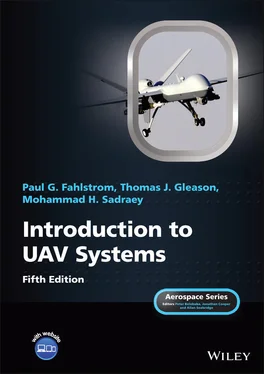There are a number of specialized military and intelligence systems for which information available to the public is very limited. An example of this is the US Lockheed Martin RQ‐170 Sentinel. The RQ‐170 Sentinel is reported to be a stealthy AV manufactured by Lockheed Martin, but limited performance data are available. It is a flying wing configuration much like the Northrop B‐2 Spirit bomber and is in the medium‐to‐large size class, with a wingspan of around 20 m (65 ft) and a length of 4.5 m. This UAV is equipped with a single turbofan engine with 41.26 kN of thrust. In 2011, Iran stated that its Army’s electronic warfare unit had downed an RQ‐170 that violated Iranian airspace along its eastern border through overriding its controls, and had captured the lightly damaged UAV.
The MQ‐1 Predator A is larger than a light single‐engine private aircraft and provides medium altitude, real‐time surveillance using high‐resolution video, infrared imaging, and synthetic aperture radar. It has a wingspan of 17 m (55 ft) and a length of 8 m (26 ft). It adds a significantly higher ceiling (7,620 m or 24,521 ft) and longer endurance (40 h) to the capabilities of the smaller UAVs. GPS and inertial systems provide navigation, and remote control can be via satellite. Cruise speed is 220 km/h (119 knots) and the air vehicle can remain on station for 24 h, 925 km (575 mi) from the operating base. It can carry an internal payload of 200 kg (441 lb) plus an external payload (hung under the wings) of 136 kg (300 lb).
The Harfang UAV is produced by Cassidian, which is a subsidiary of the French company EADS. It is about the same size as the Predator and is designed for similar missions. The configuration is different, using a twin‐boom tail structure. There are a variety of possible payloads. Its stated performance is similar to that of the Predator, but it has a shorter endurance of 24 h. It takes off and lands conventionally on wheels on a runway. Remote control can be via satellite.
Talarion is under development by Cassidian as a second‐generation successor to the Predator/Harfang class of UAVs. It uses two turbojet engines and can carry up to 800 kg (1,764 lb) of internal payload and 1,000 kg (2,205 lb) of external payload with a ceiling of over 15,000 m (49,215 ft) and speeds around 550 km/h (297 knots).
The RQ‐4 Global Hawk (see Figure 1.4) is manufactured by Northrop Grumman Aerospace Systems. It flies at high altitude and utilizes radar, electro‐optical, and infrared sensors for surveillance applications. It uses a turbofan engine and appears to have a shape that reduces its radar signature, but is not a “stealth” aircraft. It is 14.5 m (47 ft) long with a 40 m (129 ft) wingspan and has a maximum weight at takeoff of 1,460 kg (3,219 lb). It can loiter at 575 km/h (310 knots) and has an endurance of 32 h. It has a full set of potential payloads and it appears that it is routinely controlled via satellite links. More information about the Global Hawk is presented in Section 5 of Chapter 1.

Figure 2.6 Large UAVs
Some of these large UAVs are illustrated in Figure 2.6.
Expendable UAVs are not designed to return after accomplishing their mission. In the military world, this often means that they contain an internal warhead and are intended to be crashed into a target destroying it and themselves. This type of expendable is discussed further in Chapter 11and we make the argument there that it is not really a UAV, but rather a missile of some sort. There is a considerable area of overlap between guided missiles and UAVs, as illustrated by the fact that the first “UAVs” of the aviation era were mostly guided weapons. An alternative definition of an expendable is that it can (and should) be recovered if possible, but can have a very high loss rate.
The electric‐motor‐powered Raven, described in Section 2.3.4, is an example of an expendable, but recoverable, UAV. It is hand launched and uses a hand‐carried ground control station. The Raven is used to conduct reconnaissance missions out to about 5 km and is recoverable, but if it does not return or crashes during landing, the loss is considered acceptable.
However, in the past few years, a new type of lethal UAVs (as loitering munition) has emerged. This precision‐guided loitering munition is a relatively new concept and technology and generates a low (or very low) collateral damage. As example is Switchblade 300 ( Figure 2.7), designed and manufactured by AeroVironment. This UAV – which was first fielded by the US Army and Marine Corp in 2011 – utilizes a small munition to break apart prior to impact and has a low acoustic, thermal, and radar signature. Switchblade 300 is interoperable with current Puma, Raven, and Wasp UAV control stations.

Figure 2.7 Switchblade UAV
(Source: Business Wire, Inc.)
This UAV – with a mass of 2.7 kg (weight of 6 lb), a length of 2 ft, and a pusher electric motor – carries a small munition with a range of 10 km; it can be in the air for about 10 minutes. The operating altitude is 500 ft AGL (above ground level) and 15,000 ft MSL (mean sea level), with a cruise speed of 63 mph and a dash of 98 mph. Its tubular fuselage contains the battery, motor, avionics, and a payload (gimbaled nose camera). The UAV is folded inside a tube with wing sections unfolding once it gets airborne. The two wing sections are spring loaded, low‐mounted, and sweep out upon launching.
Switchblade – armed with a 40‐mm grenade‐like warhead – is meant to strike targets beyond the range – or shielded from the line of sight – of the rifles, machine guns, and other weapons of an infantry platoon or squad. Switchblade was fielded on an emergency basis in Afghanistan beginning in 2012.
There are a number of similar UAVs developed by other companies. Examples are Lockheed Martin Terminator, Mistral HERO‐30SF, Textron Systems BattleHawk, SAAB AT4 CS, Booz Allen Hamilton Vampire, Prox Dynamics Black Hornet, and Area‐I Air‐Launched, Tube‐Integrated, Unmanned System, or ALTIUS‐600.
1 What do HALE, MALE, UCAV, FLOT, AGL, MSL, and EW stand for?
2 Write classes of UAVs based on manufacturing location.
3 Write classes of UAVs based on user.
4 Write classes of UAVs based on mission.
5 Write classes of UAVs based on size.
6 Write classes of UAVs based on wing configuration.
7 Write classes of UAVs based on number of uses.
8 Write classes of UAVs based on altitude/range/endurance.
9 Which FAR part governs small UAVs?
10 What group of aircraft are often referred to as “model airplane”?
11 What is the definition of very low‐cost close‐range required by the Marine Corps?
12 What is the definition of close‐range in this chapter?
13 What is the definition of short‐range in this chapter?
14 What is the definition of mid‐range in this chapter?
15 What is the loiter capability of an endurance UAV?
16 How do we distinguish missiles from “unmanned aerial vehicles”?
17 Define intelligence as the mission for a UAV.
18 Define surveillance as the mission for a UAV.
19 Define reconnaissance as the mission for a UAV.
20 What is the mission for tier I UAVs in the US Air Force? Provide an example.
21 What is the mission for tier II UAVs in the US Air Force? Provide an example.
Читать дальше














